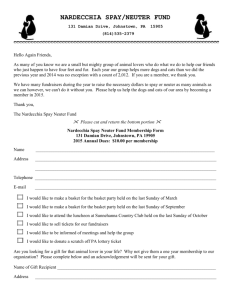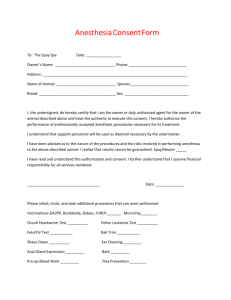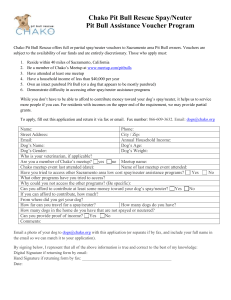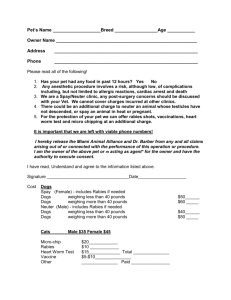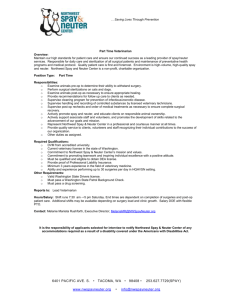Animal Control Bill Research
advertisement
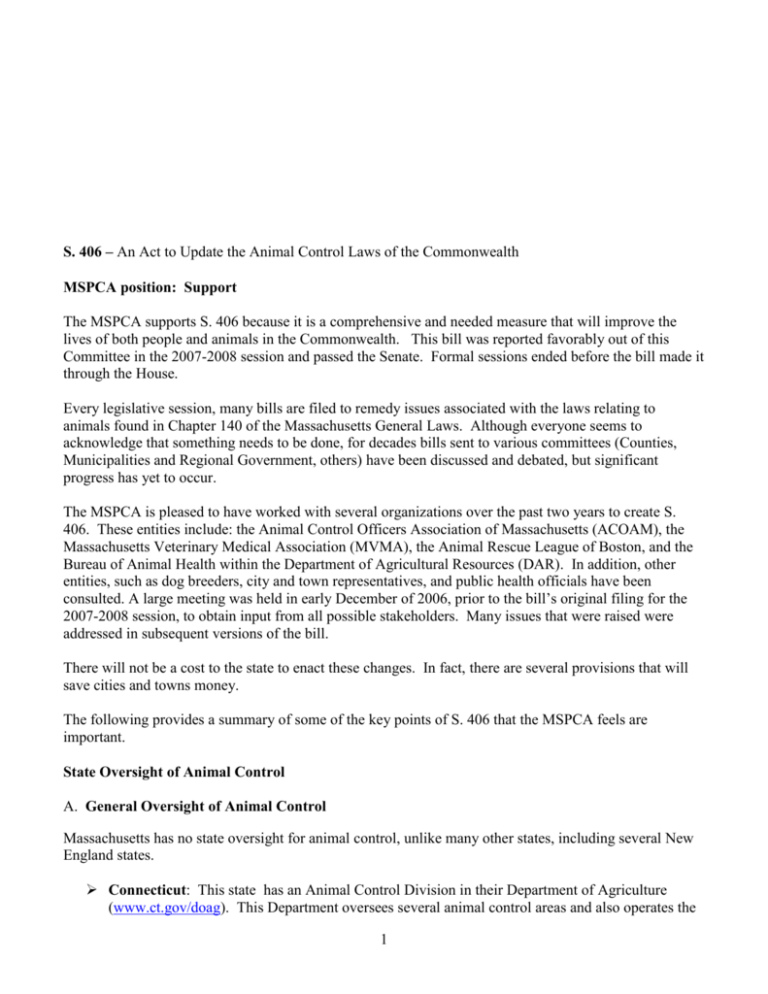
S. 406 – An Act to Update the Animal Control Laws of the Commonwealth MSPCA position: Support The MSPCA supports S. 406 because it is a comprehensive and needed measure that will improve the lives of both people and animals in the Commonwealth. This bill was reported favorably out of this Committee in the 2007-2008 session and passed the Senate. Formal sessions ended before the bill made it through the House. Every legislative session, many bills are filed to remedy issues associated with the laws relating to animals found in Chapter 140 of the Massachusetts General Laws. Although everyone seems to acknowledge that something needs to be done, for decades bills sent to various committees (Counties, Municipalities and Regional Government, others) have been discussed and debated, but significant progress has yet to occur. The MSPCA is pleased to have worked with several organizations over the past two years to create S. 406. These entities include: the Animal Control Officers Association of Massachusetts (ACOAM), the Massachusetts Veterinary Medical Association (MVMA), the Animal Rescue League of Boston, and the Bureau of Animal Health within the Department of Agricultural Resources (DAR). In addition, other entities, such as dog breeders, city and town representatives, and public health officials have been consulted. A large meeting was held in early December of 2006, prior to the bill’s original filing for the 2007-2008 session, to obtain input from all possible stakeholders. Many issues that were raised were addressed in subsequent versions of the bill. There will not be a cost to the state to enact these changes. In fact, there are several provisions that will save cities and towns money. The following provides a summary of some of the key points of S. 406 that the MSPCA feels are important. State Oversight of Animal Control A. General Oversight of Animal Control Massachusetts has no state oversight for animal control, unlike many other states, including several New England states. Connecticut: This state has an Animal Control Division in their Department of Agriculture (www.ct.gov/doag). This Department oversees several animal control areas and also operates the 1 Animal Population Control Program that is funded by a $2 surcharge on sterilized dogs and a $6 surcharge on unsterilized dogs. Maine: Maine’s Department of Agriculture, Food and Rural Resources (www.maine.gov/agriculture/aw) runs an Animal Welfare Program that is funded by the licensing of dogs and various other facilities. It has many responsibilities, including implementing and administering the animal control officer basic training and certification program. Oversight by the Mass. Department of Agricultural Resources (DAR), which they will support, would include overseeing animal control officer training and compliance, maintaining statistics on animal intake/dispositions statewide, enforcing 139A (the shelter/municipal animal control facility spay/neuter law), and overseeing the registration of shelters and animal control facilities. B. Creation of a Spay/Neuter Fund through a Dog License Surcharge While clearly a reduction of the number of homeless animals is partly an animal welfare issue, reducing these numbers will also save cities and towns money. Twenty-six states1 have state funds devoted to decreasing the number of homeless and stray animals. Five of these states –Vermont, New Jersey, New Hampshire, Illinois, and Connecticut – have dog license surcharges that are deposited into a statewide fund for subsidized sterilization programs. Based on other states’ results, Massachusetts could expect to save approximately $3 for every $1 spent on spay/neuter through this surcharge on dog licenses. Statewide Spay and Neuter Funds Save Lives. Statewide funds that subsidize low-cost sterilization programs for low-income residents have been shown to be the most effective method to decrease the number of homeless and stray animals. New Hampshire: Since the inception of New Hampshire’s spay and neuter fund or “Animal Population Control Fund” shelters and animal control offices in the state have experienced a 34% decrease in intake rates and a 75% decrease in euthanasia. That means 8,000 fewer animals have been euthanized every year (20 fewer dogs and cats a day).2 New Jersey: New Jersey experienced similar success since the inception of a state spay and neuter fund. There has been a 25% reduction in the number of dog and cat intakes and a 41% reduction in euthanasia since 1984. Additionally, the adoption rate has risen by 39%.3 AL- Companion Animal Sterilization Fund, AZ – Spaying and Neutering of Animals Fund, CO- Pet Overpopulation Fund , CT – Animal Control Program Fund, DE- Spay/Neuter Fund, FL – Florida Animal Friend Fund, GA- Dog and Cat Sterilization Fund, IL- Pet Population Control Fund, KY – Animal Control and Care Fund, LA – Pet Overpopulation Fund, ME – Companion Animal Sterilization Fund, MS-Animal Care Fund, MO- Missouri Spay/Neuter Fund, NC – Spay/Neuter Account, NH – Companion Animal Neutering Fund, NJ- Animal Population Control Fund, NY – Animal Population Control Fund, OK- Pet Overpopulation Fund, OH- Ohio Pet Fund, SC- State Veterinarians Fund, TN- Animal Population Control Endowment Fund, TX - Texas Department of Health Animal Friendly Grants, UT- Cat and Dog Community Spay and Neuter Program Restricted Account, VA - Dog and Cat Sterilization Fund, VT – Animal Spaying and Neutering Fund, WA – We Love our Pets Account 2 New Hampshire Department of Agriculture, Markets, and Food. 3 New Jersey Department of Health and Human Services (2001). 1 2 Sterilization of animals decreases not only the number of homeless and feral animals born each year, it also decreases unwanted behaviors in animals, including roaming and aggression, which often lead to the surrender and euthanasia of animals. Intact animals make up a majority of the animals surrendered to animal control and animal sheltering facilities. For example, approximately, 70% of cats and 57% of dogs that come into the MSPCA’s shelters across the state are not spayed and neutered. Statewide Spay and Neuter Funds Protect Public Health and Safety. An estimated 4.5 million people are bitten by dogs each year, with 800,000 people receiving dog bites that require medical attention. A majority of these bites involve children and the elderly. Neutering has been shown to reduce aggressive tendencies in dogs. In fact, 80% of dogs presented to veterinary behaviorists for dominance aggression were intact animals. A national study published in the Journal of the American Veterinary Medical Association found that while a minority of dogs are intact (20-23%), this population of intact dogs accounts for 70- 76% of dog bites in the United States.4 By decreasing the number of intact animals in the state, a spay and neuter fund would decrease the number of bites and animal-related injuries in Massachusetts. Statewide Spay and Neuter Funds Save Money. Substantial cost savings come from statewide subsidized spay and neuter programs by reducing the costs of services to deal with stray, abandoned and feral animals and their offspring. The International City/County Management Association (ICMA) found that in the six years since the New Hampshire Animal Population Control Program’s inception, the state admitted 30,985 fewer dogs and cats than in the six years preceding the program. ICMA estimates that New Hampshire saved $3.2 million in impoundment costs based on a per animal shelter cost estimate of $105. “The cost of the program was just over $1 million, meaning the state saved more than $2.2 million in the program’s first six years. Thus New Hampshire taxpayers saved about $3.23 for every dollar the state spent on a subsidized sterilization program.”5 New Jersey’s Statewide spay and neuter fund has also saved the state money – for every dollar spent towards spay and neuter it saved $3 in impoundment fees due to the decrease in intake rates.6 Massachusetts Has Not Solved its Homeless Pet Problem: Statewide statistics on intake and euthanasia rates are not kept in Massachusetts (S. 406 would rectify this through the creation of statewide oversight and record keeping). The MSPCA’s animal care and adoption 4 American Veterinary Medical Association: Task Force on Canine Aggression and Human Canine Interactions. A community approach to dog bite prevention. JAVMA 2001; 218:1732-1749. 5 International City/County Management Association (2001). Animal control management. Washington; International City/County Management Association. 6 Secovich, S. (2003). Case study: Companion animal overpopulation programs in New Jersey, New Hampshire, and Maine and a new program for Maine. 3 centers take in approximately 4,900 dogs and 16,500 cats each year. 37% percent of the cats brought into the MSPCA were kittens; 7% of the dogs coming in were puppies. While there is truth to the argument that puppies make up a minority of the dogs coming into animal shelters and animal control facilities, there is no truth to the argument that the creation of a spay and neuter fund would not save the lives of thousands of animals being euthanized in Massachusetts. Targeting low income households addresses the source of problem. Research studies show that animals in low-income households are much less likely to be sterilized. By targeting low-income households, people who are utilizing the low-cost spay/neuter programs would otherwise have not been able to spay or neuter their pet. Low-cost spay and neuter programs lowers the number of uncontrolled and accidental births each year. Targeted spay and neuter programs also lower the number of surrendered and stray animals brought into animal control and sheltering facilities. Studies published in the Journal of the American Veterinary Medical Association found that nearly one third of relinquishments could be directly attributed to the animals being sexually intact.7, 8 A recent study conducted by Dorr Research Corporation found that in Massachusetts 87% of owned dogs are sterilized and 94% of owned cats are sterilized. Yet, a majority of the dogs and cats coming into the MSPCA’s adoption centers are intact animals. This means that while intact animals make up a small minority of the population, they make up a large majority of the animals coming into animal control and sheltering facilities. Why a Certain Surcharge Amount: The spay and neuter fund was modeled after the success of the similar fund and low-cost spay and neuter program developed in New Hampshire. New Hampshire’s program generates $260,000 in revenue a year for their Spay and Neuter Fund by a surcharge of $2 on dog licenses from its 130,000 licensed dogs. The revenue has been enough to sustain their successful statewide low-cost spay and neuter program. Statistics from the U.S. Census Bureau indicate that Massachusetts has a population five times greater than New Hampshire (6,437,193 vs. 1,314,895). Massachusetts also has a higher poverty rate: 9.9% vs. 6.6%.9 Massachusetts population numbers indicate that revenue generated from dog license surcharge fees would be higher. The higher poverty rate in Massachusetts indicates that a higher percent of the population would be in need of low cost spay and neuter services. Ultimately, the numbers indicate that the amount of revenue generated would need to be greater in Massachusetts than in New Hampshire. A $3 surcharge would generate at least $526,890, and the bill appropriates $500,000 into the Animal Control Fund and at least $166,000 (one-third) into the spay and neuter fund. This $166,666 would fund approximately 2,800 surgeries. When targeted to the minority of low income owned unsterlized pets in Massachusetts, this amount will cover substantial ground. (To put this in perspective, it is estimated that there are more than 600,000 feral cats in Massachusetts). The $3 was derived when the $4/$2 differential was removed from an original draft (at least partially due to the request of dog breeders). Calculations with the Department of Agricultural Resources were used to derive the $3 cost, ensuring sufficient funding to allow the Department to carry out oversight and allowing for ACO training, overhead, some staff, database administration, and related travel. 7 Patronek, G.J., Glickman, L.T., Beck, A.M. et al. (1996a). Risk factors for relinquishment of dogs to an animal shelter. Journal of American Veterinary Medical Association, 209(3), 572-581. 8 Patronek, G.J., Glickman, L.T., and Beck, A.M. et al. (1996b). Risk factors for relinquishment of cats to an animal shelter. Journal of American Veterinary Medical Association, 209(3), 582-588 9 U.S. Census Bureau. (2007). State and County QuickFacts. Data derived from Population Estimates, Census of Population and Housing, Small Area Income and Poverty Estimates, State and County Housing Unit Estimates, County Business Patterns, Nonemployer Statistics, Economic Census, Survey of Business Owners, Building Permits, Consolidated Federal Funds Report. 4 To summarize, there are many benefits to cities and towns and residents of a state-wide fund and we believe these should outweigh the “cons.” Pros: Cons: Animal control officer training Adjusting license fee Reduce number of animals ACO handles Administering fund (sending money to state) Reduced impoundment costs Assistance for low-income residents for spay/neuter Reduction of feral cats & complaints Reduction in homeless/stray animals = more time for enforcement of dangerous dog laws Last session, the town clerks’ association opposed this bill because they did not agree with the surcharge on dog licenses. At the request of the town clerks, many other changes were made to earlier versions of the bill. However, the surcharge is a key provision. Removing the surcharge would undercut key programs the bill intends to establish. The claims made by the clerks’ association were that “it would take money from cities and towns and give it to the state,” and that processing the surcharge would require substantially more work for town clerks. We respectfully disagree. First, the surcharge is an additional fee (it is not being taken from the city or town). The surcharge is an appropriate means to fund programs designed to benefit animal owners. Ultimately, it will save towns and cities money, to everyone's benefit, by reducing the significant costs associated with stray animals. Also, by funding animal control officer training, it ensures competent professionals are available to protect the safety of the public from dangerous dogs and other important responsibilities of animal control officers will be carried out by trained personnel. While we understand that transferring the surcharge does require some additional work by the clerks, the bill will not create a new licensing scheme (dogs will continue to be licensed in the same way they currently are). The legislation will require the processing of one annual payment from the town to the state to transfer the $3.00 surcharge from each license. For example, a municipality that licenses 1,000 dogs would need to submit a payment of $3,000. We argue that the benefit to cities and towns, and their residents, should outweigh concerns. 5 C. Improving the Shelter Mandatory Spay/Neuter Law (Section 139A of Chapter 140) Currently, Section 139 requires shelters and municipal animal control facilities to collect a deposit if an animal is adopted without being spayed or neutered. The deposit it designed to help ensure the animal is spayed or neutered. If the owner does not get the surgery performed, the deposit is forfeited. Amendments to this spay/neuter statute in S. 406 would increase the deposit fee from $10-30 to no less than $40. The bill also allows the commissioner to impose fines for violations for non-compliance. Animal control officers and shelters can also petition for the forfeiture and relinquishment of the animal from owners who do not comply with the law. The increased spay/neuter deposit creates more of an incentive for owners to comply with the law. Updating this outdated fee will help result in higher compliance, as adopters will be more likely to get their animal spayed or neutered in order to get their deposit back. The imparting of violations will also help raise compliance levels as the risk of being fined or losing the pet gives more weight to the agreement. Twenty other states have violations incorporated in mandatory spay neuter laws and have found this to be an effective tool for compliance. D. Dangerous Dogs Situations involving dangerous dogs have been highly controversial. After lengthy discussions with those enforcing dangerous dog laws, those engaged in the administrative process involved with dangerous dog issues, as well as those involved in defending dogs deemed dangerous, provisions have been drafted to improve these laws. Below is a summary of the proposed measures: Procedural (§157): This section clearly defines the steps that must be taken in order to initiate an investigation in to the dangerousness of a dog. This section also spells out the authority of the local jurisdiction to hold an administrative hearing and recommendations for disposition (restrictions on care and control or euthanasia). The appeal process afforded to the owner of the dog in question is also defined. Section 157 also provides local officials with the discretion to seek a court order to impound a dog if, in their discretion, it is necessary. Penalties for violations (§157A): Previous fines had been not been changed in many years. The low level did not serve as a deterrent nor did it represent the true severity of violating orders. Definition of dangerous (§157B): An issue that many communities have struggled with is which behaviors or actions constitute a “dangerous” disposition. Based on studies conducted and published in periodicals such as the Journal of the American Veterinary Medical Association, as well as in consultation with certified animal behaviorists, §157B provides cities and towns with a working, objective and fair definition of “dangerous.” Preventative measures/Requirements for future confinement (§157C): This section offers cities and towns recommendations to order the future confinement and other provisions for a dog deemed dangerous. A comprehensive list is provided so that a local authority can order any combination, at their discretion, of what they feel is necessary to properly and safely confine a dangerous dog in order to protect the public from future harm. Controversial breed-specific legislation is not allowed under these sections. We believe a strong dangerous dog law is more effective than laws that target certain breeds. 6 E. Requiring Animal Control Officer (ACO) Training Animal control officers have important responsibilities, including responding to reports of stray animals, enforcing leash law violations and barking and dangerous dog ordinances. In addition, they often care for and adopt out sheltered animals. We believe that such training will increase the professionalism of this important role in our cities and towns. In return, this will provide for better care of Massachusetts’ animals, increase public safety, and create more uniform and stronger enforcement of the animal control laws. Thirteen other states have laws relating to animal control office training – Arkansas, California, Colorado, Florida, Idaho, Kentucky, Maine, Michigan, New Jersey, Ohio, Pennsylvania, Texas and Virginia. Seven of these states have set up basic animal control courses with minimum hours of training: California, Maine, Michigan, New Jersey, Pennsylvania, Texas, and Virginia. Two states, Arkansas and Florida have voluntary training programs in place (in Florida, County ACOs must undergo training). Three states, Colorado, Idaho and Kentucky have the power to establish animal control officer training. Currently, the Animal Control Officers Association of Massachusetts runs trainings, though it is not mandatory. Topics that are covered include: Equipment Handling, Animal Capture Techniques and Strategies, Livestock and Exotic Animal Handling, Wildlife Issues, Dog Bite Prevention, Animal Health Inspector Duties, Rabies Protocol, Conducting Selectmen’s Hearings, Record Keeping and Report Writing, Courtroom Procedures, Crime Scene Investigations, 4th Amendment & Exceptions to the Warrant, Cruelty Statutes and Investigating Cruelty Complaints, O.C. Spray certification plus much more. This training is funded by the dog license surcharge and supported by the Animal Control Officers Association of Massachusetts (ACOAM). F. Prohibiting the use of carbon monoxide and carbon dioxide as methods for euthanasia of dogs and cats Currently, Massachusetts law allows the use of carbon monoxide as a means of euthanasia with certain provisions. Many other states have restricted the use of these methods (including the other New England states of Connecticut, Maine and Rhode Island). Current research shows that neither carbon monoxide nor carbon dioxide is being used as methods of euthanasia for dog and cats in Massachusetts. The AVMA recommends lethal injections of sodium pentobarbital as the most humane method of euthanasia. Death by inhaling carbon monoxide and dioxide takes a longer amount of time and subsequently a longer amount of suffering: “Any gas that is inhaled must reach a certain concentration in the alveoli before it can be effective; therefore, euthanasia with any of these agents [inhalants] takes some time.” (Report of the AVMA Panel on Euthanasia, 2000) Both methods also depend on the capability of the equipment, which can fade with time or be faulty. Also both methods have been shown to have mixed results on the young, geriatric, sick, injured or pregnant animals. Carbon monoxide presents serious human safety hazards. It is extremely toxic and difficult to detect – containing no odor, color or taste. Carbon Monoxide poisoning is one of the leading causes of accidental poisoning in the Unites States. Repeated, low level exposure can also cause impaired memory, heart irregularity, muscle weakness and brain damage. 7 Carbon dioxide is heaver than air and incomplete filling of a chamber allows animals to raise their heads to avoid high exposure – resulting and a more prolonged and painful death. Precise concentrations are needed in order to ensure suffering is minimized. Studies have shown it may be distressful to animals if concentrations are too high; if concentrations are too low, pulmonary and upper respiratory tract lesions can result. Lastly, there is one typo in the bill: SECTION 27. Said chapter 140 is hereby further amended by striking out section 147A, as so appearing, and inserting in place thereof the following section:Section 147A. (a) A city or town may enact by-laws and ordinances relative to the regulation of dogs and cats, provided such by-law or ordinance shall be inconsistent with the provisions of sections 137 to 174D. This should be: Section 147A. (a) A city or town may enact by-laws and ordinances relative to the regulation of dogs and cats, provided such by-law or ordinance shall NOT be inconsistent with the provisions of sections 137 to 174D. We urge the Committee to give a favorable report to S. 406. 8

